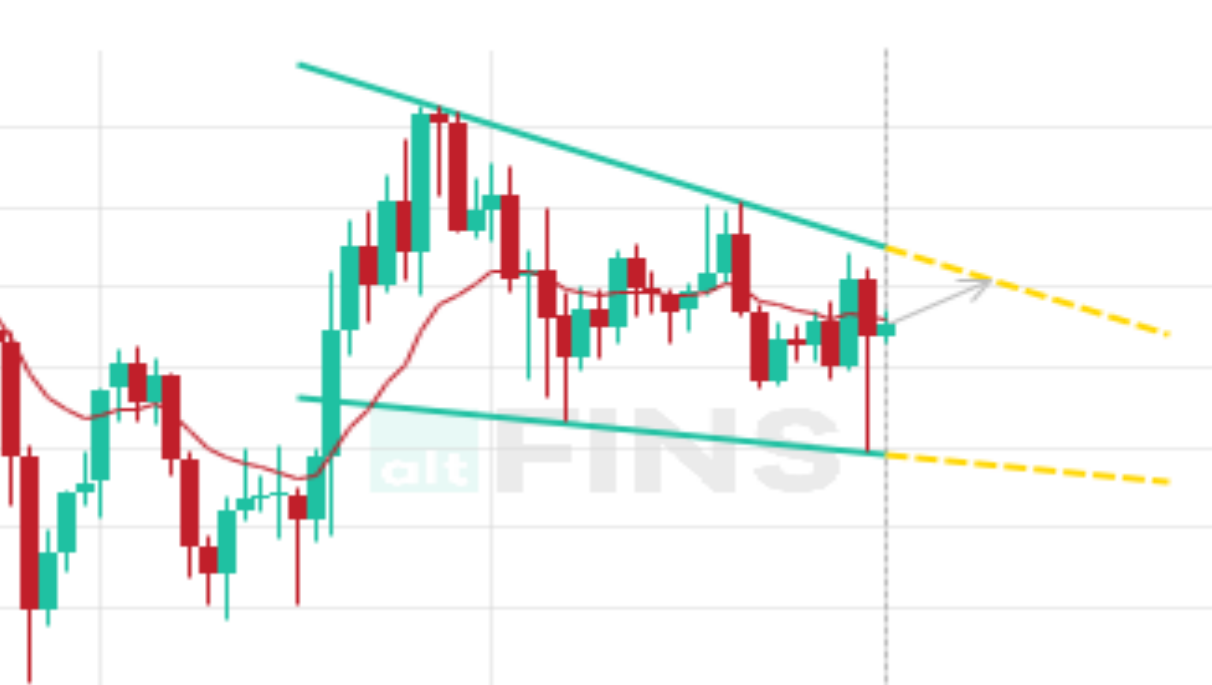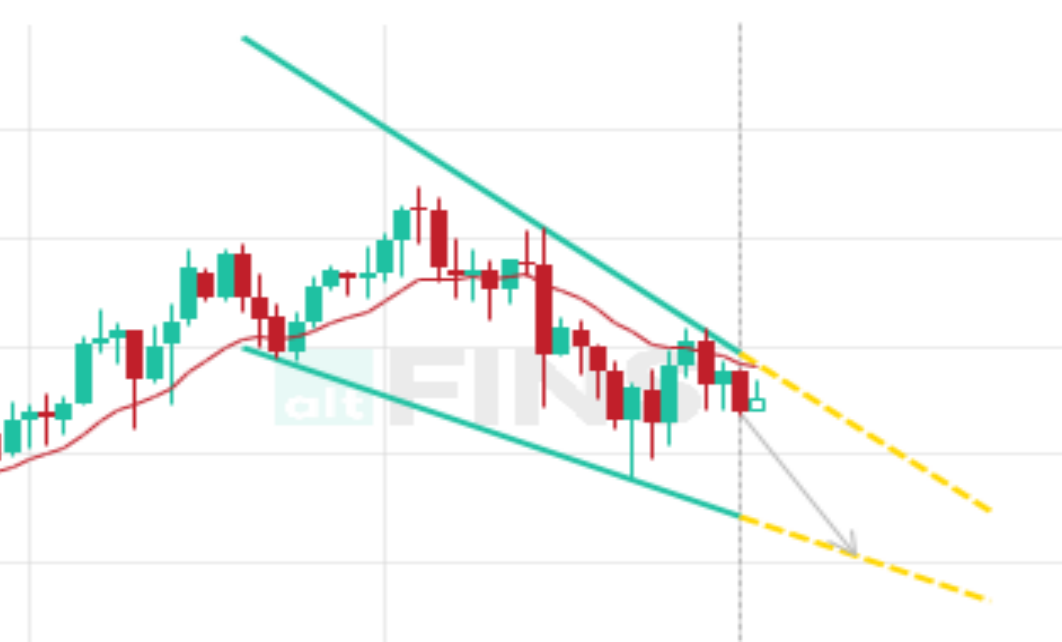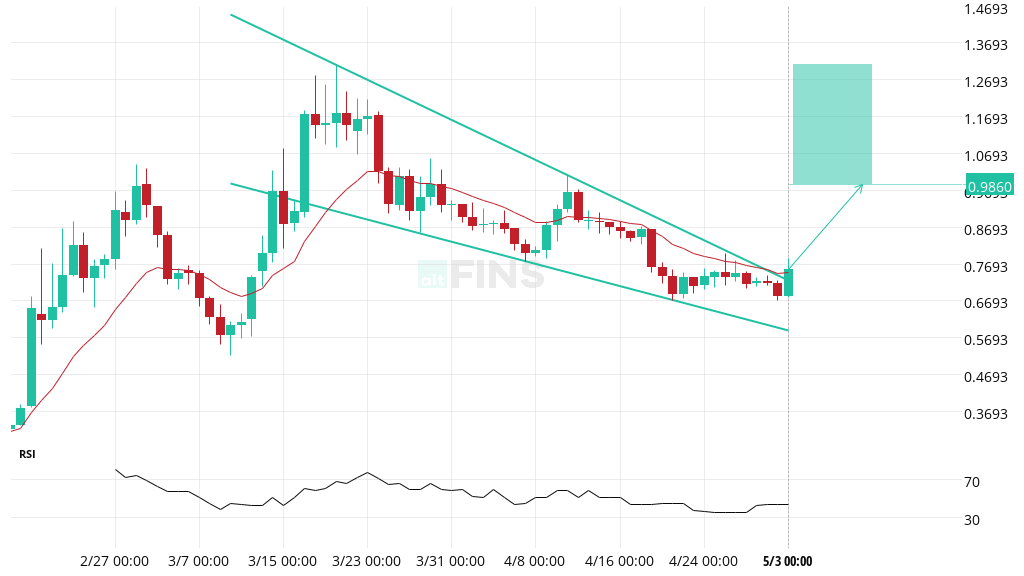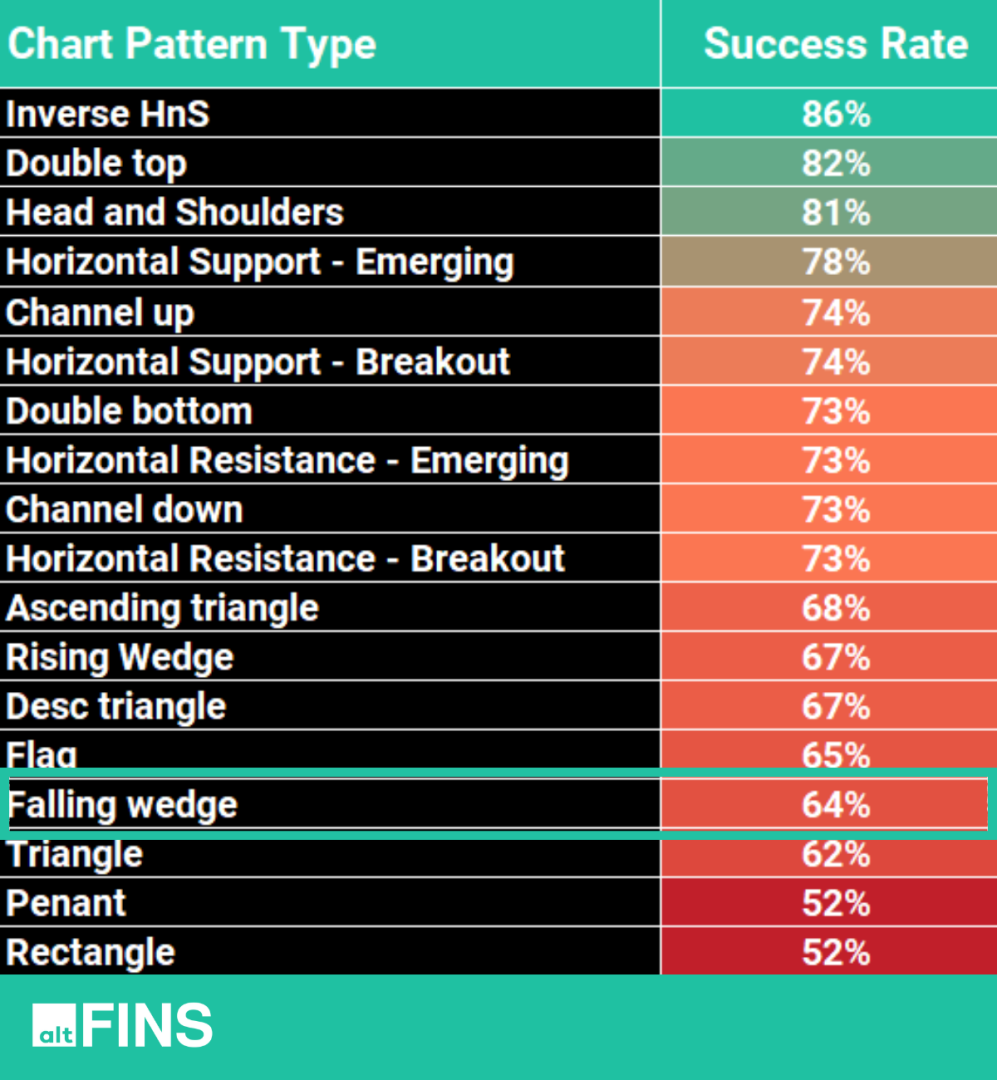Search Knowledge Base by Keyword
How To Trade Falling Wedge pattern? | Crypto Chart Pattern
The falling wedge pattern is a reversal formation in technical analysis. It features two converging trendlines sloping downward, signaling a contraction in price range and decreasing volatility.
A breakout above the upper trendline, often with increased volume, marks the pattern’s completion. Traders may use the wedge’s width to estimate a potential price target for the breakout. While indicative of a potential upward reversal, it’s essential to consider other technical indicators for a comprehensive analysis.
Bullish Falling Wedge Pattern
A bullish falling wedge pattern typically occurs in a downtrend.
- Characteristics: It is characterized by two converging trendlines, both sloping downward. The lower trendline represents support, connecting lower lows, while the upper trendline represents resistance, connecting lower highs.
- Volume: During the formation of a bullish falling wedge, trading volume often decreases. This is a key feature of the pattern.
- Breakout: The anticipated signal is a breakout above the upper trendline. This breakout is considered bullish and may signal a reversal of the previous downtrend. Traders may interpret this as a potential trend reversal or the beginning of an upward move.
- Target: The target for a bullish falling wedge is often calculated by measuring the width of the widest part of the wedge and projecting that distance upward from the breakout point.

Bearish Falling Wedge Pattern
A bearish falling wedge pattern typically occurs in an uptrend.
- Characteristics: Similar to the bullish falling wedge, a bearish falling wedge has two converging trendlines, but it develops during an uptrend. The lower trendline represents support, connecting higher lows, while the upper trendline represents resistance, connecting higher highs.
- Volume: During the formation of a bearish falling wedge, trading volume often decreases.
- Breakout: The anticipated signal is a breakdown below the lower trendline. This breakout is considered bearish and may signal a reversal of the previous uptrend. Traders may interpret this as a potential trend reversal or the beginning of a downward move.
- Target: The target for a bearish falling wedge is often calculated by measuring the width of the widest part of the wedge and projecting that distance downward from the breakout point.

In summary, the key distinction lies in the direction of the prevailing trend when the falling wedge pattern forms. A bullish falling wedge is expected to lead to an upward reversal in a downtrend, while a bearish falling wedge is expected to lead to a downward reversal in an uptrend.
Falling Wedge Trade Setup
In layman’s terms, a Falling Wedge indicates that sellers are gradually getting less desperate and less aggressive while buyers are are getting more and more interested in owning the asset. Price is declining but at a slower and slower pace, until it reaches a point where buyers absorb all the volume from sellers and push the price up. That is when a breakout occurs.
Example – Stacks (STX) – Falling Wedge Breakout

Learn more about Falling Wedge in this tutorial video.
Technical description: Two converging lines slanted downward. It usually forms after a downtrend and suggests a potential bullish reversal in the original downtrend. However, it can also appear in an uptrend, in which case, it indicates a likely continuation of that trend. Either way, Falling Wedge typically results in a bullish breakout. Falling Wedge tends to be a more reliable indicator than a rising wedge.
According to historical backtests conducted on the altFINS platform, the Falling Wedge pattern exhibits an impressive 64%!

Characteristics of Falling Wedge
The falling wedge pattern is a technical analysis chart pattern that typically signals a potential reversal in the direction of the prevailing trend. Here are the key characteristics of a falling wedge pattern:
- Slope: Falling wedges have a downward-sloping trendline for both the upper resistance line and the lower support line. The upper trendline connects the highs, while the lower trendline connects the lows.
- Converging Lines: Both the upper resistance line and lower support line converge toward each other, forming a narrowing or converging wedge shape.
- Volume: Volume tends to decrease as the falling wedge pattern develops. This decrease in volume suggests a weakening of the prevailing trend.
- Duration: Falling wedges can vary in duration, but they typically last from several weeks to several months.
- Breakout Direction: The falling wedge pattern is considered a bullish reversal pattern. A breakout from the upper resistance line to the upside is often anticipated, signaling a potential trend reversal.
- Breakout Confirmation: Traders often wait for a decisive breakout above the upper trendline with increased volume to confirm the validity of the pattern. The breakout should ideally occur before the price reaches the apex (the point where the two trendlines converge).
- Pullbacks: It’s not uncommon for the price to experience pullbacks or throwbacks after the breakout. Traders may use these pullbacks as potential entry points.
- Target Price: The price target for a falling wedge pattern is often estimated by measuring the height of the widest part of the wedge and extrapolating it from the breakout point. However, some traders may also use other technical analysis methods to set their target levels.
How to trade Falling Wedge patterns?
When price breaks the upper trend line the price is expected to trend higher. Emerging patterns (before a breakout occurs) can be traded by swing traders between the convergence lines; however, most traders should wait for a completed pattern with a breakout and then place a BUY order.
Trading the falling wedge pattern involves identifying potential buying opportunities when the price is in a downtrend and the pattern suggests a potential reversal. Here are the steps you can consider when trading a falling wedge pattern:
- Identify the Falling Wedge: A falling wedge is a technical chart pattern characterized by converging trendlines that slope downward. The upper trendline connects the highs, and the lower trendline connects the lows. The price should be moving downward within these trendlines.
- Confirm the Pattern: Ensure that the falling wedge pattern is well-formed with at least two touches on both the upper and lower trendlines. The more touches, the stronger the pattern.
- Volume Analysis: Pay attention to trading volume. Generally, volume tends to diminish as the wedge pattern forms. A decrease in volume indicates that the selling pressure may be weakening.
- Wait for Breakout: The falling wedge is a reversal pattern, and traders often wait for a breakout above the upper trendline. This breakout could be a signal that the downtrend is losing strength, and a potential reversal or bullish move may occur.
- Confirmation of Breakout: To confirm the breakout, look for a substantial increase in trading volume when the price breaks above the upper trendline. Higher volume suggests stronger conviction from buyers.
- Set Stop-Loss and Take-Profit Levels: Place a stop-loss order below the lower trendline to protect against false breakouts. Determine your target price based on the projected move of the pattern. This can be estimated by measuring the height of the widest part of the wedge and adding it to the breakout point.
How To Identify Falling Wedge Pattern on altFINS?
To identify cryptocurrencies with Falling Wedge patterns, visit these altFINS sections:
-
Chart Patterns section:
altFINS’ AI chart pattern recognition engine identifies 26 trading patterns across multiple time intervals (15 min, 1h, 4h, 1d), saving traders a ton of time.
You can filter chart patterns by type, profit potential, success rate, buy or sell direction, exchange, and more.
-
Signals Summary
Crypto signals represent a summary of pre-defined and custom filters for trading strategies. Signals Summary is a great starting point for discovering trading opportunities. Ascending triangle chart patterns can be found in the Trading Patterns category.
-
Crypto Screener – Pre-set filters
altFINS offers the best free crypto screener. It includes a wide range of pre- set filters to help find the best cryptocurrencies to invest in based on your specific trading strategy. Learn how to use crypto screener.
-
Crypto Screener – Custom filters
You can set up your own custom screens using combinations of technical indicators (SMA, EMA, RSI, MACD), variables like market cap, traded volume and price performance. You can also create price alerts for your scans.
-
Technical Analysis
altFINS’ analysts conduct technical analysis of top 60 coins. The technical analysis is simple and consistent. It follows the key concepts of Technical Analysis (TA): 1) Trend 2) Momentum 3) Volume 4) Chart Patterns 5) Support and Resistance.
Go to Technical Analysis Section
More tips:
- Lean how to trade Chart Patterns?
- What are Crypto Chart Patterns?
- How to Trade Channel Down Pattern?
- How to Trade Channel Up Pattern?
- How to Set up Chart Pattern Alerts?
- How To Trade Rising Wedge pattern?
